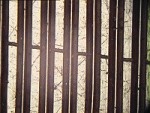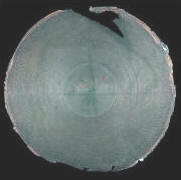|
 If you had to guess, what would you say
the image to the left represents? Part of a printed spiral inductor? How about a
printed antenna for near field communications (NFC)? Need a hint? OK, the object
is part of a project that Alexander Graham Bell, his cousin Chichester Bell, and
Charles Sumner Tainter worked on in their Volta Laboratory Associates labs. No,
it's not a neatly wound coil of telephone cable. It is a section of an audio recording
etched on a glass platter in November of 1884. After being stored at the Smithsonian
Museum for 130 years, this and a few other recording media was lent to the scientists
at Lawrence Berkeley National Laboratory with hopes that they could apply newly
invented noninvasive, non-contact techniques to scan the disc and use software algorithms
to recover the data. Thomas Edison had introduced his phonograph to the world in
1877, after which many people attempted to improve on his system both for recording
and playback. About 200 of the Volta Lab recordings are in the Smithsonian's collection
of around 400 of the earliest recordings ever made on a variety of materials. If you had to guess, what would you say
the image to the left represents? Part of a printed spiral inductor? How about a
printed antenna for near field communications (NFC)? Need a hint? OK, the object
is part of a project that Alexander Graham Bell, his cousin Chichester Bell, and
Charles Sumner Tainter worked on in their Volta Laboratory Associates labs. No,
it's not a neatly wound coil of telephone cable. It is a section of an audio recording
etched on a glass platter in November of 1884. After being stored at the Smithsonian
Museum for 130 years, this and a few other recording media was lent to the scientists
at Lawrence Berkeley National Laboratory with hopes that they could apply newly
invented noninvasive, non-contact techniques to scan the disc and use software algorithms
to recover the data. Thomas Edison had introduced his phonograph to the world in
1877, after which many people attempted to improve on his system both for recording
and playback. About 200 of the Volta Lab recordings are in the Smithsonian's collection
of around 400 of the earliest recordings ever made on a variety of materials.
 Per
National Museum of American History curator Carlene Stephens, "These recordings
were made using a variety of methods and materials such as rubber, beeswax, glass,
tin foil and brass, as the inventors tried to find a material that would hold sound.
We don't know what is recorded, except for a few cryptic inscriptions on some of
the discs and cylinders or vague notes on old catalog cards written by a Smithsonian
curator decades ago." Per
National Museum of American History curator Carlene Stephens, "These recordings
were made using a variety of methods and materials such as rubber, beeswax, glass,
tin foil and brass, as the inventors tried to find a material that would hold sound.
We don't know what is recorded, except for a few cryptic inscriptions on some of
the discs and cylinders or vague notes on old catalog cards written by a Smithsonian
curator decades ago."
What took so long for work to begin on this and other archived recordings? Mainly
it was the lack of a process for recovering the embedded data without risking damage
to or destruction of the often fragile media. Berkeley Lab's approach creates a
high-resolution digital map of the disc or cylinder. This map is then processed
to remove evidence of wear or damage (e.g., scratches and skips). Finally, software
calculates the motion of a stylus moving through the disc or cylinder's grooves,
reproducing the audio content and producing a standard digital sound file. If you
look closely at the glass disc, you can see jagged edges in the spiral pattern that
represent the complex voice print that was extracted for processing. For more information,
visit irene.lbl.gov.
So, what message did Messrs. Bell, Bell, and Tainter consider important enough
to place on this one-of-a-kind recording? Was it a secret password revealed only
to 33rd-degree Freemasons, the key to accessing an underground treasure chamber
containing the National Treasure, or maybe the code for President Chester Arthur's
nuclear football?
Maybe... but only if that word - yes, a single word - was "barometer." Barometer.
That's it. All that work for "barometer." If you say that word on the phone or in
an e-mail, know that the NSA's ECHELON program will be watching you forevermore.
Listen to it here:
Bar-om-et-or. Bar-om-et-or. Bar-om-et-or. Bar-om-et-or.
Bar-om-et-or. Bar-om-et-or.
Contact Information
The National Museum of American History collects, preserves and displays American
heritage in the areas of social, political, cultural, scientific and military history.
To learn more about the museum, visit https://americanhistory.si.edu/. For Smithsonian information, the
public may call (202) 633-1000, (202) 633-5285 (TTY).
Posted July 3, 2020
(updated from original post on 12/15/2011)
|







 "
"

